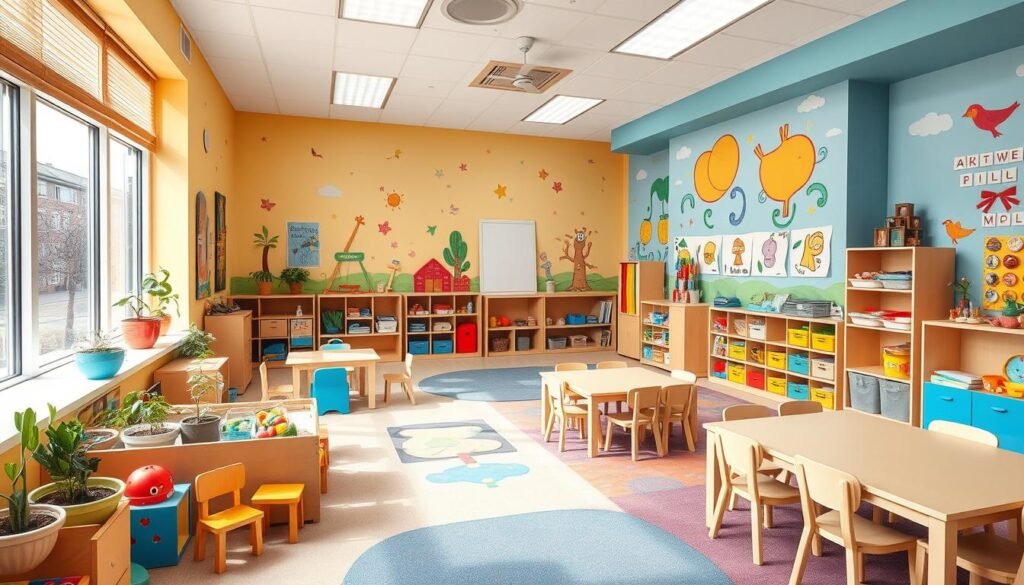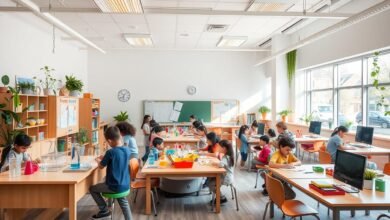Best Kindergarten Schools in the USA: What Makes Them Stand Out

The top kindergarten schools in the USA offer amazing early childhood education. They set the stage for future success. These schools focus on young children’s development, creating a great learning environment for growth and exploration.
Standout kindergartens are known for their academic excellence and new teaching methods.

Exceptional early childhood education is key for a successful education. The best kindergarten schools in the USA know how important a nurturing environment is. They help young children learn and grow, empowering them to reach their full potential.
Key Takeaways
- Best kindergarten schools in the USA prioritize academic excellence and innovative teaching methods
- Top preschools provide a quality learning environment that fosters growth and exploration
- Standout kindergartens are committed to the development of young children
- Exceptional early childhood education is the foundation of a successful educational journey
- Quality learning environments empower young children to reach their full potential
- Innovative teaching methods and academic excellence are key indicators of standout kindergartens
The Evolution of Early Childhood Education in America
The journey of early childhood education in America has been influenced by many things. These include historical events, new trends, and changes in education. Knowing about these changes helps us understand kindergarten today.
The historical development of kindergarten education has been key. It has seen the start of kindergarten programs and the use of modern technology. These changes have made a big difference.
Key Factors Influencing Early Childhood Education
- Historical development of kindergarten education
- Modern trends in kindergartens, such as technology integration and emphasis on social-emotional learning
- Recent educational reforms, including changes to curriculum and teaching methods
Recent changes in education have also shaped early childhood education. These reforms have updated what’s taught and how it’s taught. This has influenced the modern trends in kindergartens today.
As education keeps evolving, it’s important to look at recent reforms. Understanding these changes helps us see how kindergarten education has grown. It also guides us in making learning better for young kids.
| Factor | Influence on Early Childhood Education |
|---|---|
| Historical development of kindergarten education | Shaped the field and led to the introduction of kindergarten programs |
| Modern trends in kindergartens | Emphasis on technology integration, social-emotional learning, and play-based learning |
| Recent educational reforms | Changes to curriculum and teaching methods, ultimately shaping the modern trends in kindergartens |
Defining Excellence in Early Childhood Education
Excellence in early childhood education means looking at several important things. These include the quality of the learning space, the teachers’ qualifications, and the curriculum. It’s about creating a caring and supportive place for young children to grow.
This growth includes their thinking, social, and emotional skills. Quality early childhood education is key for a strong start in school and life.
Exceptional early learning centers focus on giving a well-rounded education. They aim to meet each child’s unique needs. These centers are dedicated to defining excellence in early childhood education and creating a welcoming learning space. Some key traits of these centers include:
- Teachers who love early childhood education and are very qualified
- A curriculum that fits each child’s needs
- A safe and caring place for learning that helps with social and emotional growth
Quality early childhood education is vital for kids’ success in school and later life. Exceptional early learning centers lay a strong foundation. This helps children develop the skills and confidence they need to succeed.

| Characteristics of Exceptional Early Learning Centers | Benefits for Children |
|---|---|
| Highly qualified teachers | Improved academic outcomes |
| Personalized curriculum | Increased confidence and self-esteem |
| Safe and supportive learning environment | Enhanced social and emotional development |
By focusing on quality early childhood education and defining excellence in early childhood education, these centers have a big impact. They help young children succeed in all areas of life.
Best Kindergarten Schools in the USA: What Makes Them Stand Out
The top kindergarten schools in the USA focus on early learning. They aim for academic excellence, use new teaching methods, and measure student success. These schools show their success through high literacy and math scores.
These schools also use technology and project-based learning. This approach keeps students engaged and helps them understand more deeply. Some key features include:
- Emphasis on academic excellence indicators, such as literacy rates and math proficiency
- Innovation in teaching methods, including technology integration and project-based learning
- Focus on student success metrics, such as graduation rates and college readiness
By focusing on these areas, the best kindergarten schools in the USA offer a top-notch education.
Top kindergarten schools in the USA are known for their innovative teaching and focus on student success. They often include STEM education and social-emotional learning in their curriculum. This ensures students get a well-rounded education for the future.
| School | Academic Excellence Indicators | Innovation in Teaching Methods | Student Success Metrics |
|---|---|---|---|
| Example School | High literacy rates, math proficiency | Technology integration, project-based learning | Graduation rates, college readiness |
The Role of Curriculum Development
Curriculum development is key in shaping kindergarten students’ education. A good kindergarten curriculum meets learning goals, covers various subjects, and fits different learning ways.
In early childhood education curriculum making, it’s crucial to mix play-based learning, social-emotional learning, and getting ready for school. This mix helps young students build a strong base for future learning and personal growth.
Creating an effective curriculum needs teamwork from teachers, school leaders, and parents. By focusing on what kindergarten students need, teachers can make a kindergarten curriculum that sparks a love for learning and helps develop important skills.

Some important ideas for good early childhood education curriculum making are:
- Focus on play-based learning
- Include social-emotional learning
- Prepare for school and basic skills
- Be flexible for different learning styles
By sticking to these ideas and focusing on kindergarten students’ needs, teachers can make a top-notch curriculum development. This supports the unique needs and interests of young learners.
Essential Features of Top-Rated Kindergarten Facilities
Choosing the best kindergarten for your child involves several key factors. Top-rated kindergartens offer a well-rounded education, a safe environment, and a strong foundation for the future. They have state-of-the-art learning spaces, strong safety measures, and effective technology use.
These features create an engaging learning environment. They help young children grow in many ways. For example, interactive whiteboards and outdoor play areas encourage exploration and discovery.

Technology also plays a big role in top-rated kindergartens. They use educational software and digital tools to enhance learning. This prepares children for a digital world.
The benefits of these features are many. They include a better learning experience, improved safety, and more parental involvement. They also help children prepare for future success.
- Enhanced learning experience
- Improved safety and security
- Increased parental engagement
- Better preparation for future academic success
By looking at these features, parents can choose the best kindergarten for their child. This gives them a great start in life.
Teaching Excellence and Staff Qualifications
Teaching excellence is key to kindergarten success. Teachers need to be passionate, dedicated, and always learning. They must have the right degrees and certifications in early childhood education.
Great kindergarten teachers have strong communication skills, patience, and can meet their students’ needs. They aim for teaching excellence by making lessons fun and interactive. This way, students learn and grow well.
When checking a teacher’s qualifications, look at their education, experience, and commitment to learning. Also, see if they can create a supportive and inclusive classroom.
- Education and training in early childhood education
- Experience working with young children
- Commitment to ongoing professional development
- Ability to create a supportive and inclusive learning environment

By focusing on teaching excellence and staff qualifications, schools can set students up for success. Effective teachers are crucial for a student’s educational journey. They help students start their path to a bright future.
Student-Teacher Ratios and Class Sizes
Studies show that class sizes and student-teacher ratios greatly affect education quality. Smaller classes are linked to better grades and more attention for each student. Teachers can give more personalized help and feedback in these settings.
Getting more attention from teachers boosts student engagement and motivation. It also helps them remember what they learn better. Here are some key points from research on class sizes:
- Smaller classes are linked to better grades
- More students per teacher means more attention and better results
- Best class sizes vary by subject and age, but usually have 15 to 25 students
Knowing the value of class sizes and student-teacher ratios helps improve education. Schools and governments can work to make classes smaller. They can hire more teachers or train current ones to handle bigger classes.
The aim is to give students the best place to learn. Research shows that smaller classes and fewer students per teacher are crucial. By focusing on each student, we help them do well in school and reach their goals.
| Class Size | Student-Teacher Ratio | Academic Outcomes |
|---|---|---|
| Small (15-20 students) | Low (1:10) | High |
| Medium (20-25 students) | Medium (1:15) | Medium |
| Large (25-30 students) | High (1:20) | Low |
Parent Involvement and Community Engagement
Parent involvement is key in a child’s education, especially in kindergarten. It leads to better grades, more school attendance, and a stronger community bond. Community engagement is also crucial. It builds ties between schools, parents, and the community.
To boost parent involvement and community engagement, schools can try different things. They might hold regular meetings, offer volunteer spots, and host community events. Together, parents, teachers, and the community can make a school a welcoming place for all kids.
- Parent-led classroom activities
- Community outreach programs
- Volunteer mentorship initiatives
Such programs encourage parent involvement and community engagement. They make a big difference in a child’s school life.
Accreditation and Quality Standards
Accreditation is key to making sure kindergarten schools offer top-notch education. It means they meet quality standards set by trusted accrediting agencies. These standards check the school’s curriculum, teaching methods, and learning environment.
Getting national recognition programs shows a school’s dedication to early childhood education. Also, state-level certifications and industry benchmarks confirm a school’s quality.
Important factors for accreditation include:
- Curriculum development and implementation
- Teacher qualifications and training
- Class size and student-teacher ratio
- Safety and security measures
- Community engagement and parent involvement
By following these quality standards and joining national recognition programs, schools show they care about quality education. This makes parents feel sure about their school choice. It also helps kids get a great start in life.
| School | Accreditation | National Recognition | State-Level Certification |
|---|---|---|---|
| School A | Yes | Yes | Yes |
| School B | No | No | No |
| School C | Yes | Yes | Yes |
Innovation in Early Learning Programs
Innovation in early learning is key for getting kids ready for today’s world. It includes STEM, arts, and social-emotional learning. These methods boost learning and help kids grow well-rounded.
Some main areas in early learning innovation are:
- STEM integration, which boosts problem-solving and critical thinking
- Arts and creativity focus, which sparks self-expression and imagination
- Social-emotional learning, which teaches kids about empathy and self-awareness
Benefits of Innovation in Early Learning
Innovative early learning programs make learning fun and effective. Kids see better grades, grow more creative, and develop socially. It also prepares them for a changing world, teaching them to adapt and think critically.
Implementing Innovation in Early Learning
To bring innovation to early learning, we need ongoing training and a willingness to try new things. A supportive learning environment is also crucial. Together, educators, policymakers, and families can create programs that set kids up for success.
| Area of Focus | Benefits |
|---|---|
| STEM Integration | Develops problem-solving skills, critical thinking |
| Arts and Creativity Focus | Encourages self-expression, imagination |
| Social-Emotional Learning | Develops essential life skills, such as empathy, self-awareness |
Assessment Methods and Progress Tracking
Effective assessment methods are key in kindergarten to see how students learn and what they need to get better. These methods should be right for young kids, using observations and play to check their skills. It’s also important to track how students are doing to change teaching as needed.
Some common kindergarten assessment tools are portfolios, performance tasks, and rubrics. These tools help teachers see how students are learning and share this with parents. Here are some main points about how to assess and track student progress in kindergarten:
- Observational assessments to check how students behave and learn
- Play-based evaluations to see how well students think and interact
- Portfolio assessments to follow how students grow over time
Teachers use these assessment methods and kindergarten assessment tools to really understand what students know. This way, they can teach in a way that helps students grow. By keeping an eye on how students are doing, teachers can spot where students might need more help. This makes sure every student gets the support they need to do well.
In short, good assessment methods and tracking progress are very important in kindergarten. They help teachers give great lessons and support students as they learn and grow.
| Assessment Method | Purpose | Benefits |
|---|---|---|
| Observational Assessments | To evaluate student behavior and learning | Provides insight into student strengths and weaknesses |
| Play-based Evaluations | To assess cognitive and social skills | Helps teachers understand student learning styles |
| Portfolio Assessments | To track student progress over time | Provides a comprehensive record of student learning |
Future Trends in Kindergarten Education
Looking ahead, kindergarten education will change a lot. New tech and teaching methods will play big roles. Tools like tablets and educational software will become more common.
New tech will change kindergarten a lot. For example, personalized learning approaches will let teachers tailor lessons for each student. Also, teaching will focus more on adaptive learning. This means teachers can adjust lessons as needed.
Key Trends to Watch
- Increased use of educational technology to support learning
- Greater emphasis on personalized and adaptive learning approaches
- More focus on developing social-emotional skills in young children
As kindergarten education evolves, it’s key to keep up with new trends. Educators and parents can work together to give kids a great start.
Preparing for the Future
To get ready for kindergarten’s future, we need to know about new tech and teaching methods. By staying informed and adapting, we can make sure kids get a top-notch education. This education will prepare them for success later on.
| Trend | Description |
|---|---|
| Personalized Learning | Instruction tailored to meet the unique needs of each student |
| Adaptive Learning | Instruction adjusted in real-time to meet the changing needs of students |
| Social-Emotional Learning | Focus on developing skills like empathy, self-awareness, and self-regulation |
Conclusion
As we wrap up our look at top kindergarten schools in the USA, it’s clear they’re key to early learning. These schools focus on learning, new teaching ways, and helping students succeed. They give young ones the start they need to do well.
The kindergarten years are just the start of a child’s learning journey. But they’re crucial for a lifetime of learning. The schools we talked about are dedicated to helping the next generation become leaders and active citizens.
Looking ahead, kindergarten education will keep changing with new tech, teaching methods, and understanding how kids grow. But one thing stays the same: great early learning programs help kids grow in many ways. By supporting the best kindergarten schools, we’re investing in our country’s future and all the possibilities it holds.
FAQ
What are the key factors that make the best kindergarten schools in the USA stand out?
The top kindergarten schools in the USA focus on learning, new teaching methods, and student success. They create a learning space that helps kids grow in many ways. This includes learning, social skills, and emotional growth.
How has the evolution of early childhood education shaped the modern kindergarten experience?
Early childhood education has changed a lot in America. It started with kindergarten programs and now includes technology. These changes have made kindergarten better for kids today.
What defines excellence in early childhood education?
Great early childhood education means a good learning place, skilled teachers, and a good curriculum. Top schools offer a caring space that helps kids grow in all areas.
How do the best kindergarten schools in the USA demonstrate academic excellence?
The best schools show their excellence through good reading and math skills, and how well students do. They use new teaching methods like technology and projects. This helps students learn more deeply.
What role does curriculum development play in shaping the kindergarten experience?
Curriculum is key in kindergarten. It should match learning goals, cover many subjects, and fit different learning styles. It should also include play, social skills, and getting ready for school.
What are the essential features of top-rated kindergarten facilities?
Great kindergarten places have modern classrooms, safety, and technology. These features make learning fun and safe for young kids.
What qualities and qualifications make for excellent kindergarten teachers?
The best teachers are well-trained, love their job, and keep learning. They make education great for their students.
How do student-teacher ratios and class sizes impact the kindergarten experience?
Smaller classes and fewer students per teacher help kids learn more. Teachers can give more attention, which helps kids learn better.
How can parent involvement and community engagement enhance the kindergarten experience?
Parents and the community can make kindergarten better. They help kids do well in school and feel part of a community. This is important for a good kindergarten.
What are the various accreditation options and quality standards for kindergarten schools?
Schools need to be accredited and meet quality standards. This shows they offer great education. Look for national recognition, state certifications, and industry standards.
How are innovative early learning programs shaping the future of kindergarten education?
New programs in early learning are important for today’s kids. They include STEM, arts, and social skills. These help kids learn and love school.
What assessment methods and progress tracking tools are used in high-quality kindergarten settings?
Good schools use the right ways to check how kids are doing. They use methods that fit young kids, like watching them play. This helps teachers know how to help each child.
What future trends are shaping the landscape of kindergarten education?
Kindergarten will change with new tech and teaching methods. Schools will use more technology and teach in new ways. This will make learning more personal and effective.



